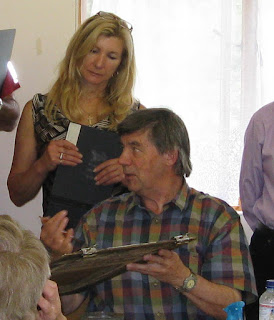 This watercolour shows a lonely farm on Tideswell Moor in Derbyshire, where you can find many similar compositions, at times without even needing to get out of your car! While it's tempting to think of snow as being white, the snow as we see it varies considerably in tone, sometimes appearing almost black when in deep shadow and backlit by strong sunshine. If you wish to push a snowy hill or mountain back into the distance lay a weak wash of blue or blue-grey over it, as you can see on the right-hand distant hill where I used cobalt blue. By comparison the left-hand hill, which is simply the white of the paper, really does come forward. To accentuate the white roof I've set it against a mid-tone background: planning your tones like this is easy with some forethought before starting to paint.
This watercolour shows a lonely farm on Tideswell Moor in Derbyshire, where you can find many similar compositions, at times without even needing to get out of your car! While it's tempting to think of snow as being white, the snow as we see it varies considerably in tone, sometimes appearing almost black when in deep shadow and backlit by strong sunshine. If you wish to push a snowy hill or mountain back into the distance lay a weak wash of blue or blue-grey over it, as you can see on the right-hand distant hill where I used cobalt blue. By comparison the left-hand hill, which is simply the white of the paper, really does come forward. To accentuate the white roof I've set it against a mid-tone background: planning your tones like this is easy with some forethought before starting to paint.
Don't just use blue over the snow areas. Watch out for reflected colours in the snow - pinks, yellows, mauves - these can really give your painting a lift, and also note where the snow cover is quite thin some of the vegetation might well show through. A good example of this is where large bands of grass are visible, where I might wash a warm colour such as yellow ochre or light red over the paper. For this, the dry brush technique where you have a large brush with little water on it, is extremely effective, especially on a rough paper surface.
This painting is featured in my book Painting Wild Landscapes in Watercolour, and for details see my website. Our website will shortly be upgraded, as it is starting to creak a bit of old age. In the meantime, Jenny and I wish you all a very Happy Christmas wherever you live in the world, and may you have a very rewarding year of painting ahead of you. We're now about to set off to the local cinema and I've been warned to take waders and carry a life raft as the waters of the Wye are rising rapidly.





































